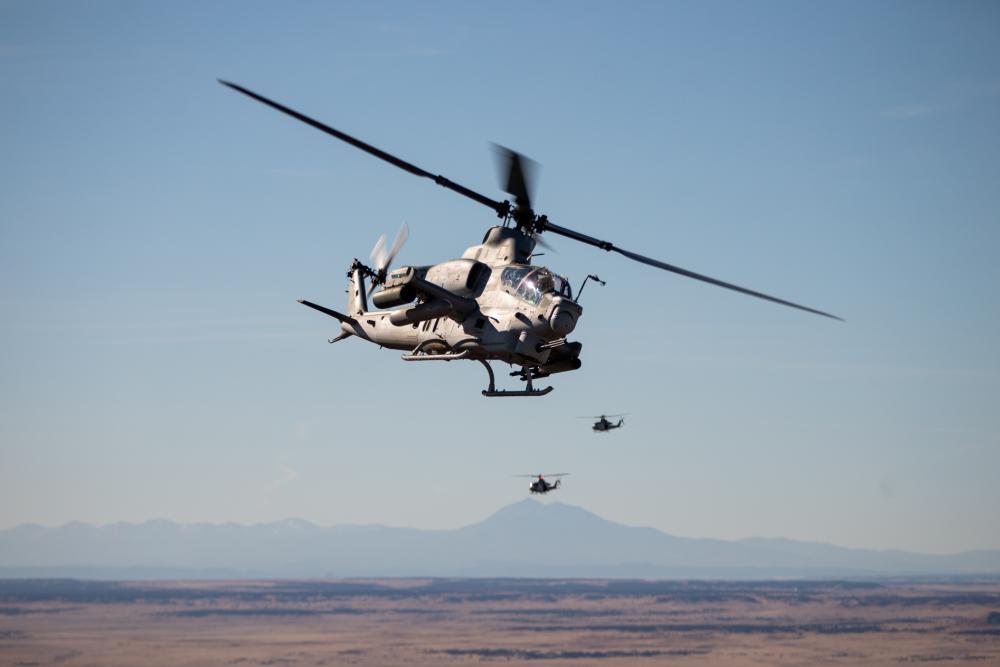Photo By Lance Cpl. Elias Pimentel |
An AH-1Z Viper helicopter and two UH-1Y Venom helicopters assigned to Marine Light……
read more
read more
LAMAR, CO, UNITED STATES
11.23.2021
LAMAR, COLORADO — Late-autumn winds rushed down from the Rocky Mountains, passed steep plateaus, and sifted through deep canyons before settling on the great plains of Colorado. These untamed plains, inhabited only by wildlife adapting to the soon-to-come winter, would shortly be the training grounds for aircraft and personnel looking to make the very same adaptations – the Marines of Marine Light Attack Squadron (HMLA) 269.
“This Colorado detachment is setting us up for success when we go to Cold Response and operate in Norway,” said Capt. Reilly Costello, an AH-1Z Viper helicopter pilot with HMLA-269. “It won’t be as cold here as it is likely to be in Norway, but it will at least give us some experience, so when we get to Norway, we’re not surprised by what we see there.”
Cold Response is an upcoming Norwegian Joint Headquarters-sponsored exercise with the goal to train in a realistic, cold-weather threat environment. Cold Response will provide U.S. forces, as well as eighteen other nations, the opportunity to strengthen interoperability with allies and partners, achieve an increased level of combat readiness, and adjust for operations in austere conditions. In preparation for Cold Response, participating units emphasized training in locations such as Colorado to ensure ample preparation for the Norwegian climate.
In addition to the colder weather, HMLA-269 needed to adjust to the drastic change in elevation, a difference of 3,619 feet than what the Marines are accustomed to in North Carolina. For aircraft, these altitude changes meant adjustments in support capabilities, weight capacities, fuel usage, and other key elements of flight.
“The altitude is something we are not used to operating in, flying around sea level at home,” said Costello. “This was definitely good training for cold-weather operations at [high] altitude and learning about the considerations you have to take into account when you’re planning a flight or planning a mission.”
Whereas North Carolina is mostly flat, Colorado added an entirely new dimension of terrain features. From mountains to canyons, the environment provided unique training opportunities for the pilots and aircrew of HMLA-269.
“We need to see different environments and different terrain in order to better prepare ourselves for the wide breadth of situations we might be put into when we go on a deployment,” said Costello. “This was a little bit different in terms of the operating areas we work in because it wasn’t just necessarily mountains, it was canyons and plateaus that we were flying around…it was good practice to see a different look on how you can utilize terrain to be effective with your helicopter.”
While in Colorado, HMLA-269 established three separate areas of operation to train in the concept of expeditionary advanced base operations (EABO). Transitioning from these three areas reflected a modernized version of World War II’s island-hopping campaign in the Pacific.
“EABO means you are operating away from your home base, maybe two or three operating areas away from where you would have your main supply point,” said Costello. “The intent of EABO is to spend long periods away from what you would call home in order to advance your capabilities or project the ability to influence something farther away from where you normally would.”
The largest component of HMLA-269’s EABO training mission was establishing and operating a forward arming and refueling point (FARP). With the support of Marines from Marine Wing Support Squadron (MWSS) 271, MWSS-272, and MWSS-273, HMLA-269 was able to rapidly refuel and arm their aircraft in a distant field environment.
“[The FARP] is a spot where some logistical elements are set up to provide ordnance and fuel,” said Costello. “It extends our range and enables us to turn around sorties much faster and be closer to the front, vice having to transit back and be limited by our combat radius.”
However, practicing and implementing the concepts of EABO with the use of a FARP did not come without its obstacles.
“There was some friction,” said Costello. “But I think that’s to be expected based on the fact that even the EABO manual is still not necessarily doctrine yet; it’s tentative.”
With obstacles come learning points, and the Marines of HMLA-269 are optimistic about future EABO implementation.
“Learning has occurred for sure,” said Costello. “Even though there were some friction points, I think you still gain experience and learn lessons from that to come back better the next time we do something along these lines.”
The combined efforts of every Marine in HMLA-269 and supporting units ensured that their deployment for training to Colorado greatly aided in preparing them for 2nd Marine Aircraft Wing’s upcoming deployment to Norway. With the lessons they learned, HMLA-269 continues to maintain the level of readiness in support of worldwide operations that the nation expects of them.
LEAVE A COMMENT
| Date Taken: | 11.23.2021 |
| Date Posted: | 11.24.2021 13:32 |
| Story ID: | 410016 |
| Location: | LAMAR, CO, US |
| Web Views: | 13 |
| Downloads: | 0 |
This content was originally published here.
